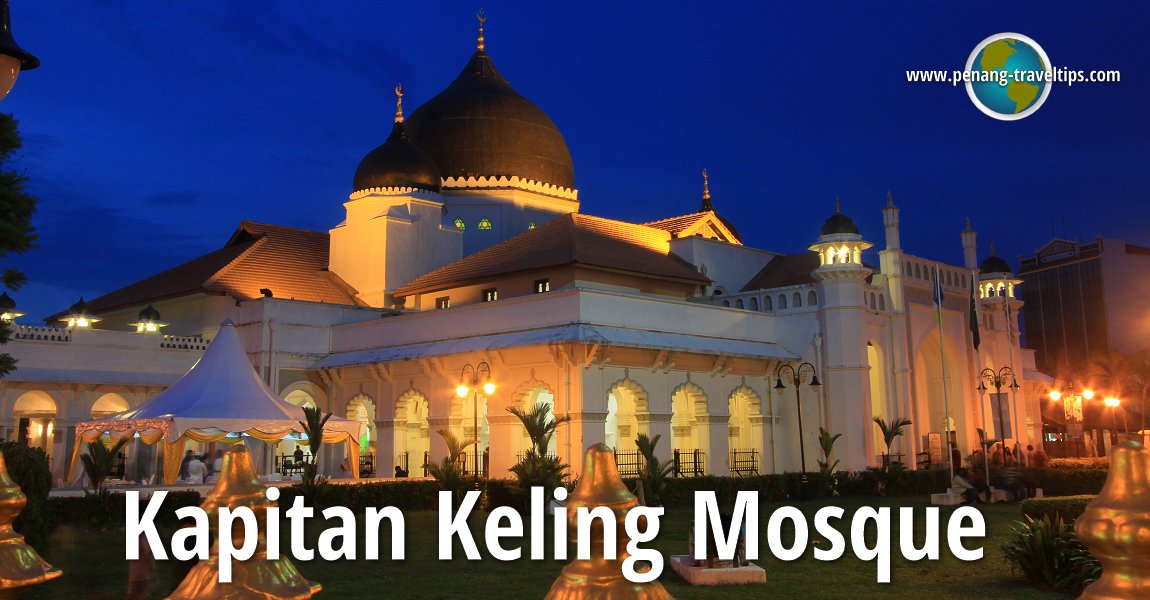 The Kapitan Keling Mosque (7 July 2012)
The Kapitan Keling Mosque (7 July 2012)
B. Melayu
The Kapitan Keling Mosque (GPS: 5.41666, 100.33758) along Jalan Masjid Kapitan Keling (formerly Pitt Street), is one of the best known mosque in Penang. Its address is on Buckingham Street, but it also has entrances on Pitt Street and Chulia Street.
Before the construction of the Penang State Mosque, the Kapitan Keling Mosque was used as the state mosque of Penang, since it is the largest historic mosque in George Town. The Kapitan Keling Mosque was named after Caudeer Mohuddeen, the head of the Indian Muslim community credited to have built it around 1800.
The name "kapitan keling" is used to denote the headman or leader of the South Indian Muslim community. The term "keling" is derived from the ancient Hindu kingdom on the Coromandel coast of South India, and the local Hokkien community corrupts the word to derive "keling-na" for Indians in general, particularly those from South India (The North Indians are pooled together with another term, "banggali", though they are not necessarily from Bengal). The title "Kapitan" is a corruption of the English word "Captain", and is used to denote the leader of the community. Similarly, the leader of the Chinese community during that period is called a Kapitan China.
The Kapitan Keling was the first Superintendent of the mosque. He brought in the builders and stones from India for the project. The original mosque structure was a single-storey rectangular building with a sloping roof on all sides and surrounded by a stone bench. It was surrounded by shophouses, with access through a narrow gateway.
It is generally accepted that the 18-acre plot of land on which the mosque stands was granted to the Indian Muslim community by the then Lieutenant Governor of Penang, Sir George Leith, in November 1801 for the building of a "Mohamedan Church for ever". This was not to be, however, as over the years, and as George Town grew, the government had to buy back parcels of land from the mosque, for the town's social amenities. This includes the land for the Central Police Station and the Campbell Street Market, which in the past was a Muslim cemetery. The Kapitan would not have to live to see this happening to his mosque, having died in 1834. The Kapitan Keling's Tomb can be found at Kampung Kolam, not far from the mosque itself. When I started this article in February 2005, the tomb was in a state of disrepair. Since then, it has been restored and spruced up.
Meanwhile, the land belonging to the mosque continued to shrink in size, brought on by encroachment and improper management. Private homes were soon within a few feet of the mosque itself. By 1903, the original 18 acres had reduced to only 8.
In 1905, the government set up the Mohammedan and Hindu Endowment Board, to supervise the administration of trust lands (tanah wakaf). An extensive urban renewal programme was underway. In the 1910s, the mosque was given a major facelift in the British Moghul Revival style, with the addition of Mughal domes and turrets, a large minaret and a madrasah, completed around 1916. The mosque complies with Kiblat, which rules that it must face the direction of the Ka'aba.
Another renovation in 1930 gave the Kapitan Keling Mosque its present appearance after the previous design was deemed impractical. In keeping with tradition, the mosque was not rebuilt, but only enlarged. Among the major work during this period included doubling the height of the central prayer hall, improvement to the ventilation system, and allowing more natural light to enter. The exterior is ochre yellowed while the interior had white marble floors and a high ceiling. The interior aisles are formed by a series of horseshoe arches, crowned with King Edward's plaques. The façade of the building and its interior were decorated with geometric designs, as human and animal forms are forbidden in Islam.
The Kapitan Keling Mosque underwent its most recent refurnishment in 2003, with a RM5 million grant, as water seepage and poor drainage were affecting the building, closing it down for a year. In this renovation, some alterations that do not compromise on the original aesthetics of the building were included. Among the new extensions was a covered walkway and a women's ablution area. Calligraphy was added to the interior of the main dome and walls, where once these were decorated with foral motifs. An Islamic Information Centre is also set up on the ground floor of the minaret.
 Discover with Timothy Videos
Discover with Timothy Videos
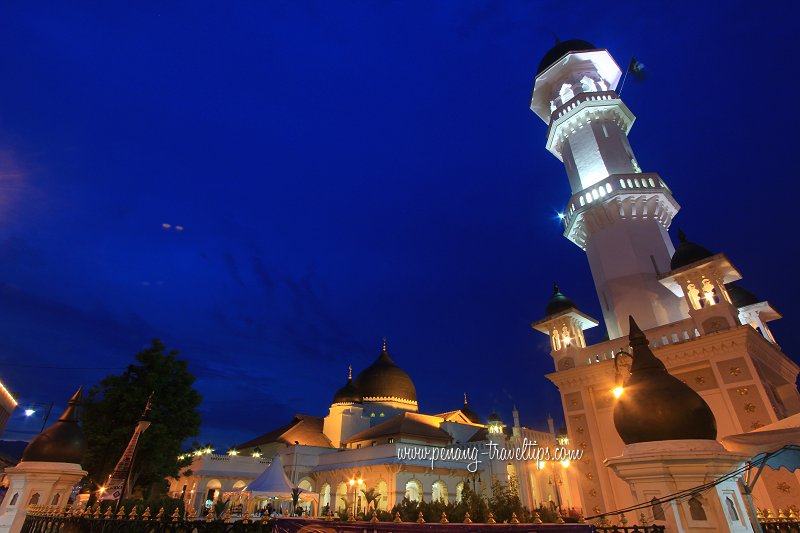 Kapitan Keling Mosque, George Town, Penang (7 July 2012)
Kapitan Keling Mosque, George Town, Penang (7 July 2012)
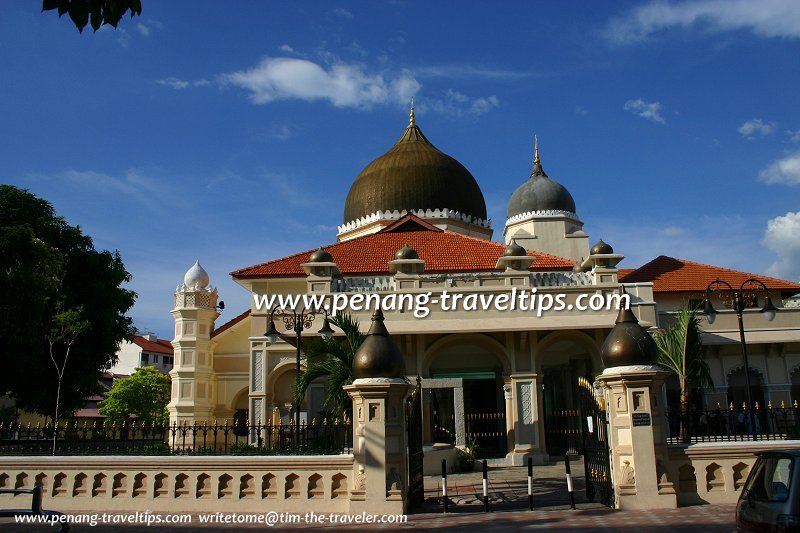 Kapitan Keling Mosque (14 March 2004)
Kapitan Keling Mosque (14 March 2004)
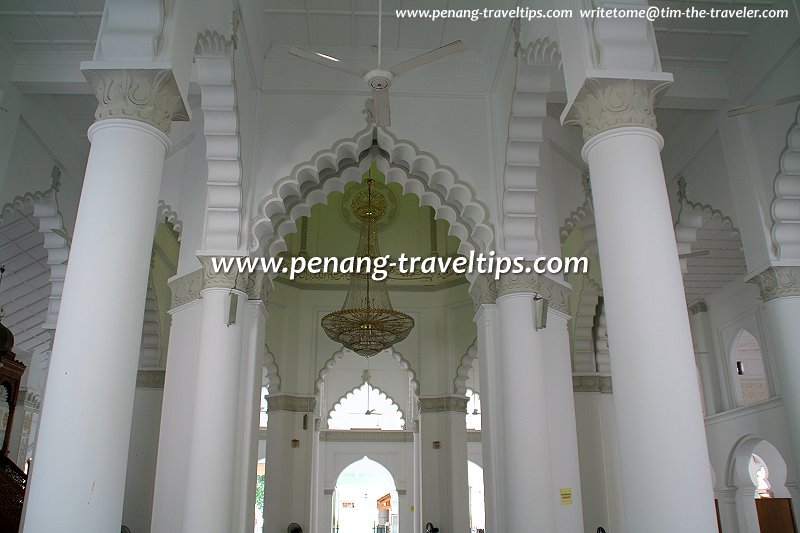 Interior of the Kapitan Keling Mosque with its central chandeliar (25 April 2007)
Interior of the Kapitan Keling Mosque with its central chandeliar (25 April 2007)
The Kapitan Keling Mosque on Google Street View
View of Kapitan Keling Mosque from Pitt Street entrance.View from Buckingham Street entrance.
View of the inner courtyard of Kapitan Keling Mosque with one of its older minarets.
Updates on the Kapitan Keling Mosque
Update: 3 December 2010Since I last wrote about the Kapitan Keling Mosque, the Kapitan Keling's Tomb has been spruced up and landscaped. It can now be easily visited.
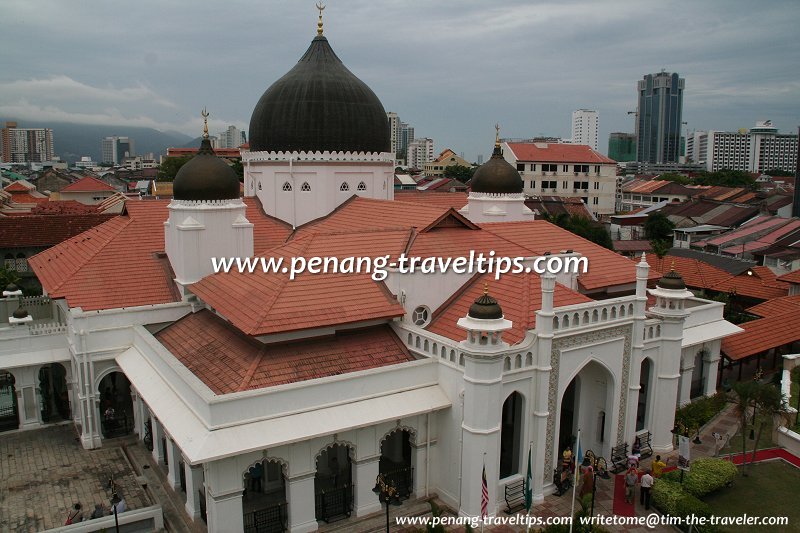 View of the Kapitan Keling Mosque from its minaret (7 July 2010)
View of the Kapitan Keling Mosque from its minaret (7 July 2010)
The Kapitan Keling Mosque is used by Muslims five times a day, seven days a week.
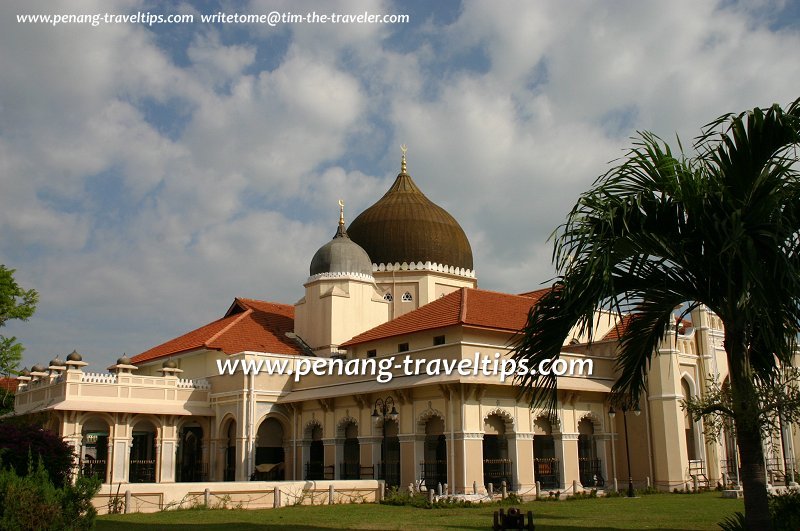 Kapitan Keling Mosque, Pitt Street, Penang (21 August 2004)
Kapitan Keling Mosque, Pitt Street, Penang (21 August 2004)
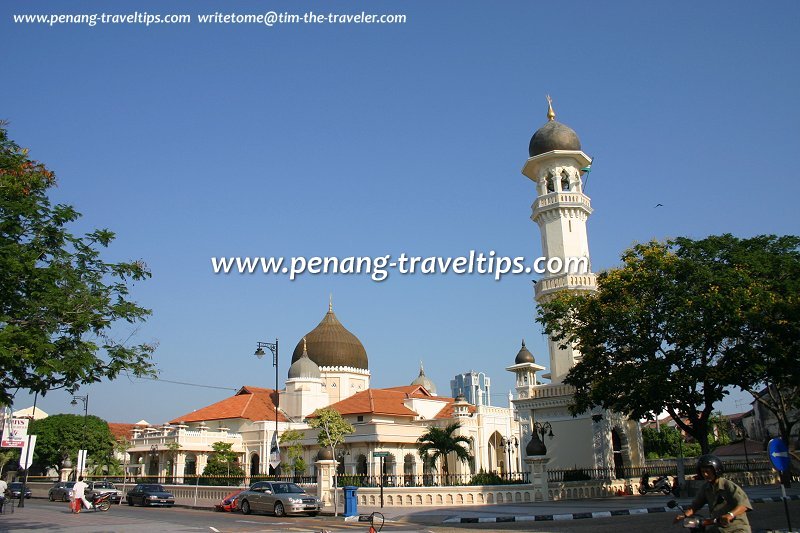 View of Kapitan Keling Mosque from Pitt Street (29 January 2005)
View of Kapitan Keling Mosque from Pitt Street (29 January 2005)
Getting there
Using the Weld Quay Ferry & Bus Terminal as starting point, cross Pengkalan Weld using the pedestrian bridge. Turn left and walk along Pengkalan Weld until the junction of Gat Lebuh Chulia. Turn right into Gat Lebuh Chulia. Walk along Gat Lebuh Chulia. At the junction with Lebuh Pantai, Gat Lebuh Chulia becomes Lebuh Chulia. Continue along Lebuh Chulia until the junction of Jalan Kapitan Keling Mosque. Cross Lebuh Chulia, then cross Jalan Kapitan Keling Mosque. Now turn left, walk along Jalan Kapitan Keling Mosque until you see the Kapitan Keling Mosque on your right. This entrance at Jalan Kapitan Keling Mosque used to be a side entrance; the original main entrance is at Lebuh Chulia.What to see and do
Admire the Indian Muslim architecture. Take note that the mosque underwent a makeover in the 1930's which radically altered its appearance. Take note that the worship hall is out of bounds to non Muslims. Take photograph of the mosque and its minaret.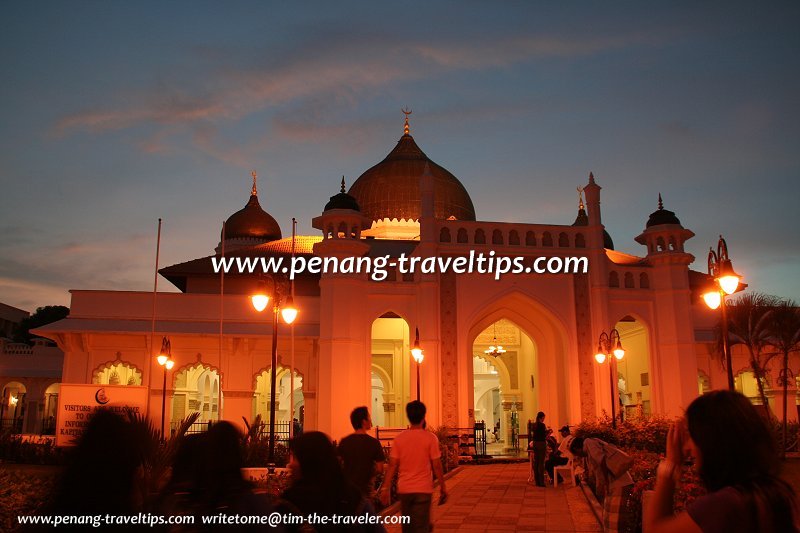 Kapitan Keling Mosque at dusk (25 July 2009)
Kapitan Keling Mosque at dusk (25 July 2009)
Nearby Sights
Kapitan Keling Mosque is located within the core zone of the George Town Unesco World Heritage Site. There are numerous sights around it that you can also visit. Their location is reference to the Jalan Kapitan Keling Mosque entrance of the mosque. Among them:- Noordin Family Tomb: Tomb of the affluent Noordin family is located adjacent to the Kapitan Keling Mosque, and can be considered to almost share a compound.
- Teochew Ancestral Temple: From the entrance of Kapitan Keling Mosque, turn left. At the junction with Lebuh Chulia, turn right and go down Lebuh Chulia. The Teochew Ancestral Temple is on the right side of Lebuh Chulia in front of the Lebuh Queen junction.
- Sri Mahamariamman Temple: From the entrance of Kapitan Keling Mosque, turn left. At the junction with Lebuh Chulia, turn right and go down Lebuh Chulia. A short distance you is the junction to Lebuh Queen to the left. Turn in, and the Sri Mahamariamman Temple is on the left side of the street.
- Nagore Shrine: From the entrance of Kapitan Keling Mosque, turn left. At the junction with Lebuh Chulia, turn right and go down Lebuh Chulia. Go past Lebuh Queen, and you will arrive at the Nagore Shrine at the next junction, Lebuh King.
- Lim Kongsi: From the entrance of Kapitan Keling Mosque, cross Jalan Kapitan Keling Mosque, then enter Lebuh Ah Quee on the opposite side of the road. Go down Lebuh Ah Quee, and you will find Lim Kongsi on the right side of the road.
- Kuan Im Teng: From the entrance of Kapitan Keling Mosque, turn left. Cross the junction of Lebuh Chulia and continue along Jalan Kapitan Keling Mosque. The Kuan Im Teng is on the left side of the road, at the junction of Lorong Stewart.
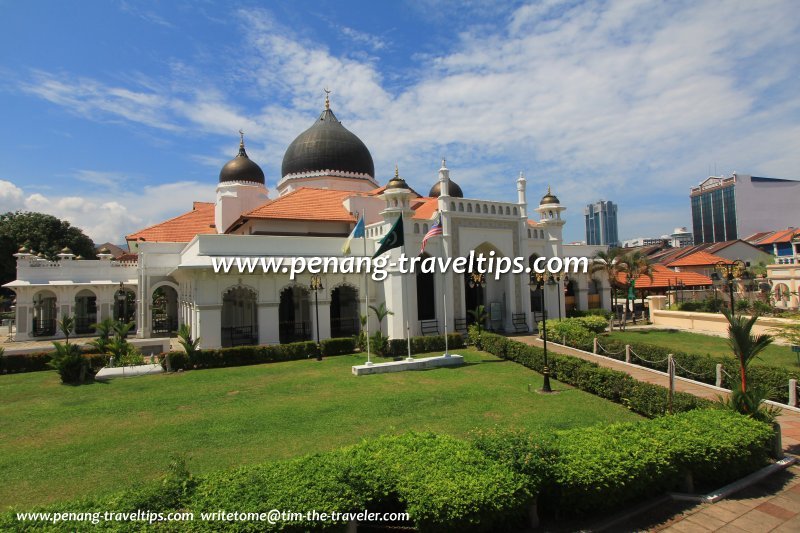 Kapitan Keling Mosque (25 January 2013)
Kapitan Keling Mosque (25 January 2013)
The Kapitan Keling Mosque is  on the map of Pitt Street
on the map of Pitt Street
The Kapitan Keling Mosque is  on the map of Buckingham Street
on the map of Buckingham Street
List of Penang Tourist Attractions, Mosques in Penang and Mosques in Malaysia

Copyright © 2003-2025 Timothy Tye. All Rights Reserved.

 Go Back
Go Back